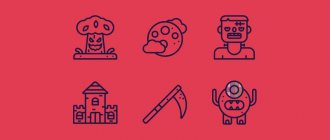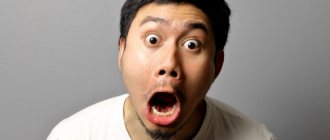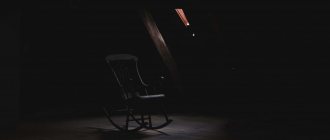Here we have listed only the types of human phobias. Fear of something, which has already grown into a phobia, is only a symptom, an external manifestation, behind which something more is hidden. The reasons for the appearance of a phobia are deep inside and are exclusively psychological in nature. You can read more about this in our other article - fears and phobias. A phobia can be formed by many situations from the past, characteristics of upbringing and perception. To get rid of phobias, you need to solve all your psychological problems associated with it.
Since it can sometimes be difficult to determine the true causes of fear and phobia, it makes sense to work on all your problems totally, otherwise you can find out for a long time what exactly the problem continues to keep your phobia afloat. The energy correction system is aimed at total work not only with the psychological aspect, but also with the body. She works very seriously and globally with all psychological problems, including fears and phobias, and also completely restores the body. This system is aimed at quick results and in-depth study of the causes of psychological problems. You can get acquainted with the technology here
.
Types of phobias:
- Places
- Natural phenomena
- Situations
- Substances
- States
- Diseases
- Mira animal
- Items
- Of people
- Actions
- Body and its parts
- That which is connected with time and death
- Abstract concepts
- Colors
- Numbers
In general - panaphobia (Panophobia) ;
Many things - polyphobia ;
Everything new - neophobia
Forms of fears
Fears can be classified according to different criteria. We will talk about some of them below, but for now we will consider the classification of emotional states that are in one way or another related to fear, based on the intensity, objectivity and strength of perception. Everything here is extremely simple, because you yourself are familiar first-hand with such things as:
- Calm. A state of complete emotional peace, when nothing worries a person, he is comfortable psychologically, he does not experience any negatively colored states associated with fear.
- Anxiety (fear, worry). A state in which a person feels the uncertainty of the situation and expects a bad turn of events. Most often, anxiety has no objective stimulus and is irrational.
- Excitement. A condition arising from anxiety and representing its intensified form. With it, a person experiences more intense nervous excitement, because doesn’t know what could happen to him and is afraid of it.
- Fear. A condition caused by a real or perceived threat. Let us remember that there is a healthy fear that warns against danger, and there is an unhealthy fear that has no basis. This is what you need to be able to cope with.
- Horror. A condition caused by intense fear. It can plunge a person into numbness, trembling, shock. A person’s active reaction to horror is absent; he is unable to eliminate the source of fear.
- Panic. A condition that is another extreme form of fear, but it is not expressed in numbness, but in the fact that a person begins to be controlled by his feelings. His actions are not subject to any logic and often harm him.
We can also identify another condition associated with fear. This is a state of fearlessness. In the case of a real threat, it can lead to extremely dire consequences. A state of fearlessness can be observed in people with an exaggerated and unhealthy sense of self-confidence, people who do not have a sense of self-preservation and suffer from mental disorders (we are not talking about situations where circumstances require being fearless).
But this is only an initial classification of fears, giving a general idea of how fear can be expressed in general. Next we present another classification - developed by the Soviet and Russian psychiatrist and psychotherapist Boris Dmitrievich Karvasarsky. He divided fears into eight large groups:
- Spatial fears (this includes bathophobia - fear of depth, acrophobia - fear of heights, agoraphobia - fear of open space, claustrophobia - fear of enclosed spaces, etc.)
- Social fears (this includes neophobia - fear of any change, heterophobia - fear of the opposite sex, etc.)
- Fear of diseases.
- Fear of death.
- Fear of sex.
- Fear of harming others.
- Fear of fears (it is this fear, by the way, that causes all phobias).
However, the classification of fears by B. D. Karvasarsky is quite complex and relative. The Austrian psychologist and psychiatrist Sigmund Freud approached the categorization of fears more specifically, dividing fears into two classes:
- real fears;
- neurotic fears.
Canadian-American psychiatrist Harold Irwin Kaplan classified fears in a similar way. He divided them into:
- constructive fears;
- pathological fears.
But the most interesting thing is that these two scientists agreed that the first fears (real and constructive) are necessary for a person so that he can save his own or someone else’s life, and the second (neurotic and pathological) can be considered as a sign of an illness that destroys a person .
There is also an interesting theory from stress research specialist Yuri Viktorovich Shcherbatykh, proposed by him in 2000. According to his concept, there are three types of fears:
- Natural fears. This includes everything that is justified by natural phenomena (hurricanes, earthquakes, tsunamis, thunderstorms, etc.). Such fears are completely justified and even adequate people are susceptible to them. It is human nature itself to fear everything unknown (we repeat once again that we talked about this in the article “Fear. What to do with it?”, as well as in the article “Psychological foundations of fear”). Despite the fact that today people perfectly understand the origin of most natural phenomena, fear of them remains, and it is natural. This category of fears also includes the fear of various animals, insects and other living creatures.
- Social fears. Yu. V. Shcherbatykh, taking as a basis the results of various sociological surveys, came to the conclusion that the greatest fear among people is, of course, the threat of war. And this fear is characteristic even of those who have never participated in hostilities. Among other social fears, he names fear of crime, hooliganism and disorder, fear for one’s loved ones, fear of death, fear of poverty, fear of public speaking and publicity in general, fear of change and some others.
- Inner fears. As children, many of us were frightened by some kind of woman or little gray wolf who would come and take us away if we did not obey. We have grown up, but many people still have the fear of looking in the mirror at night, looking under the bed, or pulling their leg out from under the blanket. A person’s imagination, which received the corresponding message in childhood, is capable of generating a variety of monsters that no spiders or hurricanes can compare with. And it is very, very difficult to stop being afraid of such things (by the way, read our article “What Famous People Were Afraid of,” where there is a lot of confirmation of what was said).
The line between these three groups of fears is very thin and extremely difficult to see. For example, if a person experiences internal fear of the quagmire that is sucking him in, it can to a certain extent be attributed to both social and natural fear. Fears can cleverly intertwine with each other and have an inexplicable impact on a person.
But the classification of fears does not end there, because there is also a gradation by age:
- Childhood fears. When a child just begins to live, his gene stock of reflexes works. So, the baby may be afraid of being thrown up when he hears loud noises or sees strangers. Such reactions are normal and constructive, but life moves on. If parental upbringing was incorrect or the child was influenced by some special circumstances, he may develop neurotic fears. For example, if a child was punished by being locked in a closet, he may develop claustrophobia, and if his mother once lost him in a shopping mall, he may begin to fear open spaces and large crowds of people.
- Fears of an adult. An adequate adult understands perfectly well that there is no Boogeyman in a dark closet, but he can be terrified by the mere sight of snakes, spiders or praying mantises. Likewise, he may be afraid that a loved one will leave him, or experience stage fright; to be afraid of being worse than others or to consider oneself unworthy of many benefits; overly control your other half or constantly worry about your children, etc.
- Fears of older people. The fears of older people may differ from those of children and adults. They are specific. In addition to the fear of the dark, mice and hurricanes, there may be a fear of getting sick and becoming a burden to your family. But at the same time, the fears that previously bothered us disappear, for example, the fear of being misunderstood by others, the fear of not experiencing love in life. However, some fears can go to extremes: grandmother, afraid of strangers, does not open the door even to her relatives, grandfather, fearing transport, does not come closer than 200 meters to the road, etc.
This is the primary classification of fears. In fact, this topic is worthy of more careful study and serious scientific work. But we only set ourselves the task of showing how diverse this unique phenomenon called fear is, and we hope that we were able to accomplish this task.
You can read about how to work with fears in the articles “Fear. What to do with him?" and “Method of systematic desensitization to combat fears,” and we will continue this material with very interesting information. As you know, fear can become uncontrollable and obsessive, i.e. develop into a phobia. So below we will talk about the most common phobias of people.
Phobias of situations
Staring closely at others - scoptophobia ;
Touching - aphenphosmophobia ;
Sexual harassment - Contreltophobia ;
Rape - virginitiphobia ;
Accident - Dystychiphobia ;
Atomic explosion - atomosophobia (Atomosophobia) ;
Radiation - radiophobia (Radiophobia) ;
Physical or moral punishment - Rhabdophobia ;
Porky - Mastigophobia ;
Critics - Enissophobia ;
To be tied up is Merinthophobia ;
Being strangled is Pnigophobia ;
Choking - anginophobia ;
Being in a crowd is Ochlophobia ;
Lunch and dinner conversations - Deipnophobia ;
Getting dirty - Rhypophobia ;
Being hypnotized is hypnophobia (Hypnopliobia) ;
Lawsuits - Liticaphobia ;
Marriage - Gamophobia ;
Surgical operation - tomophobia (To mo phobia) ;
Religious ceremonies - teleophobia ;
Being alone is isolophobia ;
Hearing good news is Eupophobia ;
Being unnoticed is athazagoraphobia ;
Being ridiculed is Katagelophobia .
Symptoms
It is worth understanding the differences between fear, anxiety, anxiety and panic. Anxiety is not related to anything specific. “Uneasy at heart” - this is how this feeling can be explained. Anxiety accompanies a person at certain moments in life (at night, when visiting gloomy houses). Once in conditions that are comfortable for him, a person calms down. But if the patient has a fear of rain, he will not forget about his fear. Moreover, seeing rain on TV, the patient will feel a panic attack.
Phobias of objects
Asymmetrical things - asymmetriphobia ;
Small objects - microphobia ;
Large objects - megalophobia ;
Sacred objects - Hagiophobia ;
Cars - motorophobia ;
Bicycles - Cyclophobia ;
Books - bibliophobia ;
Hours - Chronometrophobia ;
Computers - cyberphobia ;
Crosses and crucifixes - Staurophobia ;
Crystal and glass - crystallophobia ;
Dolls - Pediophobia ;
New drugs - neopharmaphobia ;
Fabrics - Textophobia ;
Bird feathers - pteronophobia (Pteronophobia) ;
Flutes - Aulophobia ;
Machines - mechanophobia ;
Mirrors - Catoptrophobia ;
Money - Chrometophobia ;
Needles and prickly objects - Aichmophobia ;
Bullets - Ballistophobia ;
Firearms - Hoplophobia ;
Nuclear weapons - nucleomituphobia (IMucleomituphobia) ;
Papers - papyrophobia ;
Pins - Enetophobia ;
Razors - Xyrophobia ;
Telephones - Telephonophobia .
Treatment, methods of assistance and self-help
You need to get rid of several aspects at once. To overcome the fear of life, they work in the following areas:
- Correction of the psychotype, smoothing out the basic characteristics that have a particularly negative impact on life.
- Eliminate anxiety.
- Elimination of depression.
- Learning to respond to negative moments in a new way.
A variety of assistance techniques are used:
- Cognitive behavioral therapy. The doctor finds out what the root of the problem is. Teaches a person to respond to standard calls in a new way. Move away from the usual pathological pattern, which is usually avoidance. Otherwise, you won’t be able to get rid of the fear of life.
- Personal therapy. Aimed at finding the underlying cause of the pathological process. Like the cognitive-behavioral technique, it requires several dozen sessions.
When depression develops, antidepressants and tranquilizers are prescribed. The former help cope with the disorder at a basic level. But you need to take them for six months or longer, only then will there be any benefit. The latter are taken in short courses and according to the situation, to relieve anxiety, fear, and prevent panic attacks.
Action phobias
Swimming - ablutophobia ;
Going to bed - Clinophobia ;
Driving a car - amaxophobia ;
Giving birth - Maleusiophobia ;
Moving - Tropophobia ;
Dressing is Vestiphobia ;
Working on a computer is a cyberphobia ;
Cooking - Mageirocophobia ;
Crossing the street - Agyrophobia ;
Dancing - Chorophobia ;
Making decisions - decidophobia ;
Failure to fulfill one's duty is paralipophobia ;
To be treated - pharmacophobia (Pharmacophobia) ;
Going to the doctor - iatrophobia ;
Treat teeth - odontophobia ;
Drinking - dipsophobia ;
Eating, swallowing - phagophobia ;
Flying - aviophobia (Aviophobia) ;
To operate (by surgeons) - Ergasiophobia ;
Writing is graphophobia ;
Kissing - Philemaphobia ;
Studying - Sophophobia ;
Treat (by doctors) - opiophobia ;
Moving - kinetophobia ;
Expressing your opinion is doxophobia ;
Riding a train - siderodromophobia ;
Travel - Hodophobia ;
Going to school - didaskaleinophobia ;
Talking is Laliophobia ;
Talking on the phone is phonophobia ;
Speaking in public is glossophobia ;
Sleeping - somniphobia ;
Sitting - Katisophobia ;
Thinking - Phronemophobia ;
Work - ergophobia (Ergophobia) ;
Walking - ambulophobia ;
Washing - Abultophobia ;
Having sex is Coitophobia ;
To sin is enosiophobia ;
Losing your virginity is Primeisodophobia ;
Steal - kleptophobia ;
To undress in public is Dishabillophobia ;
Urinating - urophobia ;
Waiting for a long time - macrophobia ;
Getting fat - obesophobia ;
Opening your eyes is optophobia ;
Returning home is nostophobia .
How the disorder manifests itself
The fear of living life to the fullest is accompanied by typical disturbances in behavior and well-being. Among the symptoms of a conditional pathological process:
- Meager, gray everyday life
A person lives according to a standard pattern. In the best case scenario, the patient lives in a work-home-work scenario. No new impressions or sensations. A person suffering from a phobia seems to forbid himself to exist normally, to do something new, to change his environment. A life sparse in events will continue if nothing is changed and a course of recovery and rehabilitation is not taken. This is not the fastest process.
- Fear of taking risks
Part of the fear of life. Of course, no one wants to take unnecessary risks. But if we are talking about a reasonable risk, a willingness to do something new, a reasonable person will agree. Not someone who suffers from a phobia. For him, it’s a problem to take a different route to work, not to mention something more serious, about some radical changes in life. This leads to another symptom.
- Extreme degree of conservatism, even retrograde
A person goes to work along the same road, shops in the same stores, and tries not to change anything in the established routine. This is a kind of compromise with reality: I play by your rules, but only to the extent that it is safe for me. It can reach the point of absurdity, it all depends on the severity of the pathological process.
- Pessimism
Inability to rejoice. Tendency to see everything in sad, black and gray tones. The motto of such a person is - today it’s bad, but tomorrow it will be even worse. Violation of adequate perception of reality immediately affects all areas of life. It is impossible to work normally, it is impossible to act in one’s own interests. And there’s no talk of personal life at all.
- Anhedonia. Inability to experience pleasure. And in all its aspects.
- Lack of will
Apathy. The reluctance to do something is superimposed on a purely physical inability to act. This is not even Oblomov, who dreamed diligently and put all his strength into dreams. This is a squeezed lemon that doesn’t even have the strength to think or plan. Since all the energy is spent on strong negative experiences, it flows away as if through a sieve. The insidiousness of the psychology of fear of life lies precisely in the gradual erosion of a person’s strength. This continues constantly and gets worse every year.
- Tendency to exaggerate everything
Catastrophization. The boss shouted - I’m a worthless person, good for nothing. Some kind of disease has appeared - it is certainly fatal. And if it’s not fatal, then next time I’ll definitely be in trouble. And so on. This approach is initially destructive and creates a problem literally out of thin air. The fly turns into an elephant and closes the mind's eye, preventing you from rationally weighing the circumstances.
- Fear of strong emotions
Strong emotions force a person to express himself. A patient with a phobia, with a fear of living, does not strive for expressed positive experiences. Quite the opposite. Closes himself from them.
- Inadequacy in thinking
The tendency to dramatize even ordinary situations, to exaggerate the extent of the problem, to see danger where there is none. Also paranoid, excessively cautious.
Interestingly, people with a fear of living often become hostage to chronic, protracted depression. It needs to be dealt with under the supervision of a psychotherapist. A psychologist will not help here. Medicines are needed. Panic attacks are also possible - attacks of strong unreasonable fear.
Phobias of things related to time and death
Death and dying - Thanatophobia ;
Cemeteries - coimetrophobia ;
Time and clocks - chronophobia (Chronofobia) ;
Corpses - necrophobia (Necrophobia) ;
Rotting and decay - sellophobia (Seplophobia) ;
Mogil - plakophobia (Ptacophobia) ;
Being buried alive is Taphephobia .
Content
- 1 Alphabetical list of phobias 1.1 A
- 1.2 B
- 1.3B
- 1.4 G
- 1.5 D
- 1.6 E
- 1.7 Yo
- 1.8 F
- 1.9 Z
- 1.10 I
- 1.11th
- 1.12 K
- 1.13 L
- 1.14 L
- 1.15 M
- 1.16 N
- 1.17 O
- 1.18 P
- 1.19 R
- 1.20 C
- 1.21 T
- 1.22 U
- 1.23 F
- 1.24 X
- 1.25 C
- 1.26 H
- 1.27 Sh
- 1.28
- 1.29 b
- 1.30 S
- 1.31 b
- 1.32 E
- 1.33 Yu
- 1.34 I
- 1.35 AZ and others
Classification
Sexual phobias
- Philophobia – fear of falling in love, experiencing a strong feeling;
- Oneirogmophobia – fear of night ejaculation;
- Gamophobia – fear of getting married, entering into a legal union;
- Contreltophobia – fear of sexual violence;
- erotophobia – fears about intimacy;
- Virginitiphobia – fear of being raped;
- Cypridophobia – fear of prostitutes, fear of contracting a sexually transmitted disease;
- Philemaphobia – fear of kissing;
- Primeisodophobia – fear of losing innocence.
Fears related to the human body
- Phalacrophobia – fear of hair falling out;
- odontophobia – fears about any manipulation of teeth and visits
- dental office;
- euphobia (Gertuphobia) – fear of one’s own and others’ knees;
- Levophobia – fear of body parts located on the left;
- dextrophobia (Oextro phobia) – fear of body parts located on the right;
- medomalacuphobia – fear of losing potency;
- Chirophobia - unpleasant sensations due to someone else's hands;
- Ommetaphobia – anxiety about looking into another person’s eyes;
- Gymnophobia – fear of the sight of a naked body;
- Rhytiphobia – fear of wrinkles;
- dysmorphophobia – fear of flaws in one’s body;
- Chaetophobia – fear of any hair;
- Medorthophobia – fear of the male genital organ;
- Osmophobia – fear of body odors;
- Hemophobia – aversion to blood.
Concerns about specific locations
- Scolinophobia – rejection from school;
- Gephyrophobia – fear of being on a bridge;
- nosocomephobia – fears about staying in medical institutions;
- Eicophobia – fear of being at home;
- Batophobia – fear of elevated buildings;
- lygrophobia (Lygophobia) – neurosis due to a darkened room, poorly lit areas;
- Ecclesiophobia – worries about church organizations;
- topophobia – neurosis in specific objects;
- Domatophobia – neurosis due to all the buildings in a row;
- Theatrophobia – serious worries about theater performances or the theater stage;
- Atephobia – fear of destroyed houses and buildings;
- Nyctohylophobia – fear of dense, gloomy forests;
- Koinoniphobia – worries about being in any room;
- Hagiophobia - neurosis due to religious rituals and ceremonies, shrines, clergy.
Phobias due to natural phenomena
- Scotophobia – neurosis due to darkness;
- Auroraphobia – fear of the northern lights;
- Cremnophobia - neuroses due to an abyss, abyss, ravine, slope;
- Nephophobia – dislike of clouds;
- sciopophobia – fear of shadows;
- Homichlophobia – neurosis in front of fog;
- Lilapsophobia – experiences before a hurricane, storm;
- Chionophobia – fear of snow cover;
- Ancraophobia – neurosis due to drafts and wind;
- Ligyrophobia – fear caused by sharp sounds;
- Nyctophobia - neurosis in front of the night, a dark room;
- acrophobia – fear of being above the ground;
- Ombrophobia – fear of heavy rain;
- Brontophobia – fear caused by lightning and thunderstorms;
- anemophobia – fear that arises due to significant air gusts or storms;
- Cryophobia is a neurosis due to the coming frosts in winter.
Fear of color
- Chromophobia – a neurotic condition due to all shades and colors;
- Leukophobia – a neurotic condition due to the color white;
- porphyrophobia – a neurotic condition due to the color purple;
- xanthophobia (Xanlhophobia) – a neurotic condition due to the color yellow;
- erythrophobia (Erythrophobia) – a neurotic condition due to the color red;
- Melanophobia (Metanophobia) is a neurotic condition due to the color black.
Social phobias
- Isolophobia – fear of being alone;
- Teleophobia – neurosis due to religious rituals, religion itself;
- Katagelophobia – fear of being ridiculed;
- Deipnophobia – worries about upcoming conversations at the table during meetings with guests;
- Athazagoraphobia – fear of being unnoticed and ignored;
- Enissophobia – neurosis due to criticism;
- Ochlophobia – fear of crowds;
- aphenphosmophobia - neurosis from other people's touches;
- Liticaphobia – fear of legal proceedings, exposure;
- scoptophobia – excessive isolation, fear of being funny in the opinion of others;
- Eupophobia – fear of receiving positive news.
Fear of insects
- Arachnephobia – neurosis due to a spider;
- parasitophobia (Parasitophobia) – a neurotic state due to a parasitic insect, hostility to bedbugs and lice;
- Myrmecophobia – dislike of ants;
- Acarophobia – neurosis due to insects and ticks;
- Mottephobia – dislike of moths;
- Apiphobia – neurosis due to the expectation of getting a bee sting.
Phobias due to numbers
- Octophobia – fear of the number 8;
- Triskadekaphobia – neurosis due to the number 13;
- Numerophobia – worries about every number.
Phobias associated with death
- Thanatophobia - neurosis about the thought of one’s sudden death and funeral;
- Coimetrophobia – neurosis due to the cemetery;
- Sellophobia – fear of the processes that occur with the body after burial;
- necrophobia - neurosis due to funeral rites, fear of the dead;
- Taphephobia – fear of being buried alive;
- plakophobia (Ptacophobia) – neurosis due to gravestones.
Fear of space
- Stenophobia – avoidance of narrow, cramped corridors;
- Aeroacrophobia – neurosis due to high open areas;
- Spacephobia – neurosis due to empty rooms, emptiness;
- Agoraphobia – fear of open spaces;
- Cenophobia – worries about empty rooms;
- Agyrophobia – panic in front of the road and streets;
- Claustrophobia – terror in a confined space.
Phobias in front of abstract concepts:
- Technophobia – electronic devices and new technologies cause horror;
- logophobia (Logophobia) – neurosis when it comes to the need to speak out;
- dikephobia (Dikepbobia) – fear that the truth will be restored;
- hylephobia (Hylepnobia) – neurosis due to materialism;
- apeirophobia - neurosis due to infinity, limitlessness of space;
- Ideophobia – fears due to thoughts;
- psychophobia (Psychophobia) – hostility towards the mentally ill;
- symmetrophobia – neurosis due to symmetry;
- allodoxaphobia – neurosis due to other people’s opinions;
- heresyphobia – unconventional ideas cause panic;
- Ouranophobia – fear of looking at the sky;
- Melophobia – neurosis due to loud music;
- Satanophobia – fear of evil spirits, evil, the coming of the devil;
- Mythophobia - experiences due to traditions, myths, legends;
- Cainophobia – fears about everything new: things, feelings;
- Gnosiophobia (Gnosiophobta) – new knowledge and information causes panic;
- Philosophobia – neurosis due to philosophical ideas;
- metrophobia – poetry causes horror;
- Hadephobia – fear of going to hell;
- prosophobia (Prosophobta) – worries about progress;
- Theologicophobia – religious teachings cause stress;
- demonophobia (Demonophobia) – worries about demons, evil spirits;
- phasmophobia (Phasmoprtobia) – neurosis due to ghosts, ghosts;
- Nomatophobia – fear of calling someone by name;
- Hellenologophobia – a neurotic condition due to the presence of scientific terms;
- Theophobia - fear of receiving divine punishment, a fateful blow, punishment from religion, God;
- Symbolophobia – fear of symbols, phenomena, objects, events, prophetic dreams and omens.
Phobias of people of other nationalities
- Teutophobia – neurosis due to Germans, Germany and everything German;
- Japanophobia - neurosis due to the people of Japan and everything Japanese;
- Heliophobia – neurosis due to Greece, Greek traditions;
- Russophobia – neurosis due to Russia and everything Russian;
- Judeophobia – neurosis due to Jews and everything Jewish;
- Anglophobia – neurosis due to Great Britain as a whole;
- Francophobia - neurosis due to the inhabitants of France and everything French;
- Sinophobia – neurosis due to the people of China and everything Chinese;
- xenophobia – fear of representatives of a different religion, cultural development,
- states and nations.
Fear of fauna inhabiting water bodies
- Ichthyophobia – fish make you nervous;
- selachophobia (Selachophobta) – panic about sharks;
- Bufonophobia – dislike of toads;
- Ophidiophobia – dislike of reptiles;
- scoleciphobia – dislike of worms;
- herpetophobia – dislike of snakes and lizards;
- Batrachophobia – dislike of frogs;
- Ostraconophobia – dislike of shellfish.
Phobias due to others
- Teratophobia – people with an underdeveloped physical appearance, freaks cause panic and fear that a sick child will be born;
- Wiccaphobia – worries about sorcerers and witches;
- harpaxophobia – fear of being robbed, neurosis due to thieves;
- Pogonophobia – a person with a beard is terrifying;
- Gynophobia – dislike of ladies;
- androphobia - dislike of gentlemen;
- heterophobia (Heterophobia) – avoidance of people of the opposite sex;
- Peladophobia – people with shaved skulls are terrifying;
- Eisoptrophobia – neurosis due to one’s own mirror image;
- parthenophobia (Parthenophobia) – neurosis due to a chaste girl;
- Dentophobia – neurosis due to dental treatment, fear of the dentist;
- Hobophobia – people in distress cause panic;
- Coulrophobia (Coulrophobla) – clowns make you nervous;
- Anthropophobia – neurosis due to all people in general;
- Syngenesophobia – fears due to the presence of a loved one;
- Homophobia – homosexuals make people nervous;
- politicophobia (Politicophobia) – anxiety due to being next to a person from the political sphere;
- ephebiphobia – makes young people and teenagers nervous;
- Pedophobia – dislike of a child;
- gerontophobia (Gerontophobia) – old people and elderly people are afraid of it;
- Pentheraphobia – makes the mother-in-law or mother-in-law nervous.
Animal concerns
- Lutraphobia – makes otters nervous;
- Alektorophobia – roosters and hens make you nervous;
- Ornithophobia – birds make you nervous;
- doraphobia – wool and fur cause panic;
- Cynophobia – dogs make you nervous;
- aclurophobia – makes cats nervous;
- Taurophobia – cows and bulls make you nervous;
- Zemmiphobia – makes rats nervous;
- musophobia – neurosis due to the mouse;
- Hippophobia – dislike of horses;
- agrizoophobia – fear of street and forest animals;
- Zoophobia - fear of all representatives of fauna.
Phobias caused by food
- Oenophobia – neurosis due to the type of wine;
- Lachanophobia – neurosis due to vegetables;
- Cibophobia – fear of eating;
- Carnophobia – intolerance to meat products;
- Alliumphobia – neurosis due to garlic;
- Methyphobia – experiences due to alcoholic beverages.
Fears of doing certain activities
- Ergophobia – neurosis due to performing work that requires special knowledge and experience;
- dipsophobia – fear of drinking any liquid;
- macrophobia (Macrophobia) – neurosis due to expectation of something;
- Vestiphobia – fear of choosing clothes for certain purposes, wearing them under weather conditions;
- Phronemophobia – fears due to the need to think;
- agyrophobia - neurosis due to the need to cross a street or highway;
- Mageirocophobia – neurosis due to cooking;
- Hodophobia – fear of traveling, making a trip;
- Paralipophobia – fear of not doing what was promised, of failing;
- graphophobia - fear of writing something;
- phonophobia – fear of making a phone call;
- Glossophobia – fear of speaking in front of crowds of people;
- optophobia (Optophobia) – fear of seeing something repulsive, hostile, being scared;
- Kleptophobia – fear of stealing something;
- Enosiophobia – fear of breaking religious commandments, sinning;
- Cyberphobia – fear of computer technology;
- Somniphobia – fear of falling asleep;
- Katisophobia – fear of sitting down;
- Ergasiophobia – worry about a planned action or behavior;
- Doxophobia – fear of voicing one’s position;
- Ambulophobia – fear of walking;
- Maleusiophobia – neurosis due to the onset of labor and contractions;
- Pharmacophobia – fear of taking medications;
- Chorophobia – fear of performing dance movements;
- amaxophobia – fear of driving;
- Tropophobia – fear of moving to another apartment and the associated changes;
- Clinophobia – fear of falling asleep;
- urophobia – fear of urinating in the wrong place;
- Decidophobia – fear of deciding something;
- Kinetophobia – fear of movement;
- Laliophobia – neurosis before speaking;
- Sophophobia – neurosis due to studying, visiting educational institutions;
- Abultophobia – neurosis due to washing, bathing, and performing water procedures;
- nostophobia – fear of returning home;
- Dishabillophobia – neurosis due to public nudity or removal of an item of clothing.
Phobias due to specific objects
- Motorophobia – fear of cars and driving them;
- Crystallophobia – fear of glass and crystal products;
- Aichmophobia – fear of cutting and piercing objects, needles, knives and pointed parts;
- Chrometophobia – fear of money;
- Bibliophobia – fear of reading books;
- siderodromophobia - fear of trains;
- Aerophobia – fear of flying on airplanes;
- pediophobia (Pediophobia) - neurosis due to life-size figures, dolls, wax figures - objects depicting a model of a person;
- Hoplophobia – fear of bladed weapons and firearms;
- Telephonophobia – fear of using the telephone;
- Ballistophobia – fear of bombs, shells, bullets, rockets, throwing objects;
- Microphobia – fear of small details;
- Textophobia – fears about fabrics and textiles;
- Enetophobia – fear of piercing objects, pins, etc.;
- neopharmaphobia – fear of taking new medications;
- Cyclophobia – fear of bicycles, two-wheeled mode of transport;
- asymmetriphobia – fear of objects with asymmetry;
- nucleomituphobia (IMucleomituphobia) – fears due to threats of nuclear war, the use of nuclear weapons;
- Mechanophobia – fear of mechanical objects, machines;
- Papyrophobia – fear of paper, clean and wet, dirty;
- Xyrophobia – fear of razors;
- Chronometrophobia – fear of clock mechanisms, the passage of time;
- Megalophobia – fear of huge objects;
- Cyberphobia – fear of electronic equipment, computers.
Fears due to sunlight or other light
- Photophobia – intolerance to any light sources;
- Electrophobia – fear of the electrical system;
- xerophobia – fear of deserts, dry climates;
- Selaphobia – fear of a sharp flash of light;
- photoaugliaphobia (Photoaugliaphobia) – fear of strong lighting;
- Heliophobia – fear of direct exposure to sunlight;
- Eosophobia – fear of dawn, the beginning of a new day;
- Phengophobia – fear of objects that shine from the sun's rays.
Phobias before an emergency
- Rhypophobia – fear of dirt, lack of cleanliness, pollution;
- hypnophobia (Hypnopliobia) – fear of sleeping due to fear of dying;
- Pnigophobia – fear of suffocation;
- Mastigophobia – neurosis due to corporal punishment, spanking;
- Anginophobia – fear of angina, suffocation or choking;
- Rhabdophobia – fear of physical or mental punishment;
- Dystychiphobia – fear of accidental tragedy;
- tomophobia – neurosis due to the likelihood of surgical intervention;
- Atomosophobia – fear of a nuclear explosion;
- Merinthophobia – neurosis due to rope;
- Radiophobia – fear of receiving radioactive radiation.
Neurosis due to certain conditions
- Atychiphobia – fear of failure;
- Zelophobia – fear of jealousy;
- cherophobia – neurosis due to the upcoming fun;
- Dinophobia – fear of dizziness and nausea;
- Menophobia – fear of menstruation and accompanying pain;
- Atelophobia – fear of not conforming to perfection, ideal;
- Mnemophobia – fear due to past events;
- eleutherophobia (Eleutherophobta) – neurosis due to freedom;
- Hypengyophobia – fear of unnecessary responsibility;
- obesophobia – fears of being overweight;
- asthenophobia – fear of losing strength, energy, being weak;
- Leniaphobia (Peniaphobia) – fear of becoming poor;
- Plutophobia – fear of getting rich;
- Angrophobia – fear of experiencing and receiving rage and anger from others;
- Soteriophobia – fear of being dependent on others;
- Doxophobia – fear of expressing gratitude, expressing your opinion;
- Illyngophobia – fear of feeling dizzy if you look down;
- monophobia – fear of being alone;
- gerontophobia – neurosis due to old age and accompanying weaknesses and illnesses;
- Oneirophobia – fear of dreaming;
- Hedonophobia - neurosis due to receiving pleasure, pleasure, joy;
- Kopophobia – fear of overwork;
- alginophobia (Algiophobia) – fear of experiencing pain;
- Hormephobia – neurosis due to random stress and the appearance of shock.
Phobias of certain substances
- Iophobia (iophobia) – fear of poisoning from poison;
- Seplophobia – neurosis due to rot;
- aurophobia – fear of gold and products made from it;
- metallophobia – neurosis due to metal and objects made from it;
- amatophobia (Amathophobia) – fear of dusty surfaces, constant cleaning;
- Coprophobia – fear and aversion due to feces.
Water fears:
- Potamophobia - neurosis due to river flows, waterfalls;
- Antlophobia – fears due to the risk of floods;
- Thalassophobia – neurosis due to bathing, swimming in the oceans, seas;
- hydrophobia (Hydrophobia) – neurosis due to water, approaching a body of water, the occurrence of convulsive movements when swallowing;
- Limnophobia – neurosis due to the depth of lakes.
Fear of the forest or nature:
- Dendrophobia – neurosis due to a large number of trees;
- Anthrophobia – neurosis due to flowers;
- Mycophobia – fear of being poisoned by mushrooms;
- hylophobia (Hyiophobia) – neurosis due to forests;
- Olfactophobia – fear of smells;
- Botanophobia – neurosis due to flora.
Phobias before illnesses
- Cardiophobia – fear of having a heart attack, heart disease;
- Dementophobia – fear of clouding of mind, madness;
- Toxicophobia – fear of getting poisoned, intoxicating the body;
- amnesiphobia – fear of losing memory;
- paraphobia – fear of deviations in sexual development;
- Luiphobia – fear of contracting syphilis;
- Diabetophobia – fear of diabetes;
- Molysmophobia – fear of contracting infectious diseases;
- Verminophobia – neurosis due to infection from microbes and viruses;
- Scotomaphobia – fear of losing vision;
- Coprastasophobia – fear of constipation, stool retention;
- epistaxiophobia – fear of having a runny nose;
- monopathophobia (Mohopathophobia) – fear of a certain disease;
- Anginophobia – neurosis due to angina;
- cancerophobia (Cancerophobia) – fear of getting cancer, oncology;
- patroiophobia – neurosis due to genetic diseases;
- Febriphobia – fear of colds and flu;
- Proctophobia – fear of getting hemorrhoids;
- Cynophobia – fear of contracting rabies from dogs;
- Vaccinophobia – neurosis due to vaccination;
- traumaticphobia – fear of injury or physical harm;
- Acarophobia – fear of getting a tick bite, infection from small insects, scabies and itchy skin;
- phobia (Phobophobia) - neurosis due to the appearance of a phobia, obtaining an obsessive state of neurosis;
- Pathophobia – fear of getting sick;
- Leprophobia – fear of getting leprosy, leprosy;
- Phthisiophobia – fear of contracting tuberculosis;
- Cypridophobia – fear of contracting sexually transmitted diseases;
- Chorophobia – fear of getting cholera;
- Poliosophobia – fear of possible kidney disease, polio;
- Dermatosiophobia – fear of contracting a skin disease;
- Phthiriophobia – fear of lice infestation;
- meningitophobia – fear of getting a brain disease;
- Trypanophobia – fear of getting injured or getting an injection.
The list of phobias that are common to people is very diverse. Unfortunately, a person is not able to control his own fears and completely get rid of them. But with the help of specialist psychologists or psychotherapists, it is possible to reduce the problem and make your life easier.











